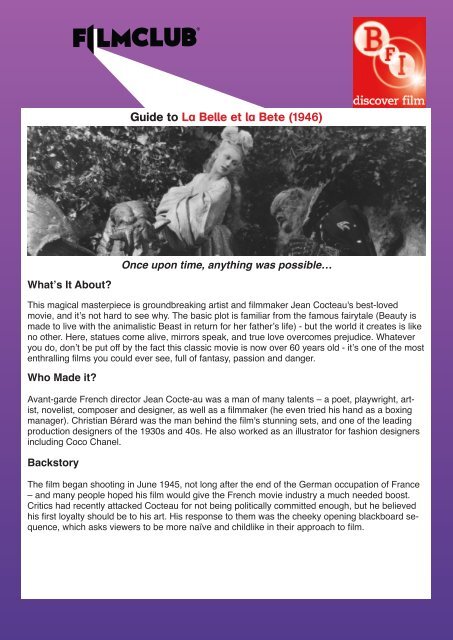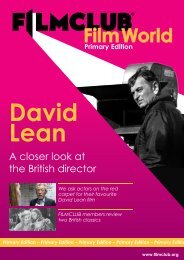Guide to La Belle et la Bete (1946) - Filmclub
Guide to La Belle et la Bete (1946) - Filmclub
Guide to La Belle et la Bete (1946) - Filmclub
Create successful ePaper yourself
Turn your PDF publications into a flip-book with our unique Google optimized e-Paper software.
What’s It About?<br />
<strong>Guide</strong> <strong>to</strong> <strong>La</strong> <strong>Belle</strong> <strong>et</strong> <strong>la</strong> B<strong>et</strong>e (<strong>1946</strong>)<br />
Once upon time, anything was possible…<br />
This magical masterpiece is groundbreaking artist and filmmaker Jean Cocteau's best-loved<br />
movie, and it’s not hard <strong>to</strong> see why. The basic plot is familiar from the famous fairytale (Beauty is<br />
made <strong>to</strong> live with the animalistic Beast in r<strong>et</strong>urn for her father’s life) - but the world it creates is like<br />
no other. Here, statues come alive, mirrors speak, and true love overcomes prejudice. Whatever<br />
you do, don’t be put off by the fact this c<strong>la</strong>ssic movie is now over 60 years old - it’s one of the most<br />
enthralling films you could ever see, full of fantasy, passion and danger.<br />
Who Made it?<br />
Avant-garde French direc<strong>to</strong>r Jean Cocte-au was a man of many talents – a po<strong>et</strong>, p<strong>la</strong>ywright, artist,<br />
novelist, composer and designer, as well as a filmmaker (he even tried his hand as a boxing<br />
manager). Christian Bérard was the man behind the film's stunning s<strong>et</strong>s, and one of the leading<br />
production designers of the 1930s and 40s. He also worked as an illustra<strong>to</strong>r for fashion designers<br />
including Coco Chanel.<br />
Backs<strong>to</strong>ry<br />
The film began shooting in June 1945, not long after the end of the German occupation of France<br />
– and many people hoped his film would give the French movie industry a much needed boost.<br />
Critics had recently attacked Cocteau for not being politically committed enough, but he believed<br />
his first loyalty should be <strong>to</strong> his art. His response <strong>to</strong> them was the cheeky opening b<strong>la</strong>ckboard sequence,<br />
which asks viewers <strong>to</strong> be more naïve and childlike in their approach <strong>to</strong> film.
The Production<br />
Shooting in the immediate aftermath of World War II, the crew had <strong>to</strong> deal with film shortages,<br />
b<strong>la</strong>ckouts and constant noise from p<strong>la</strong>nes flying overhead. To make matters worse Cocteau fell seriously<br />
ill, while star Jean Marais had <strong>to</strong> spend five hours every morning having animal hair stuck<br />
<strong>to</strong> his face and body in order <strong>to</strong> <strong>to</strong> p<strong>la</strong>y the Beast.<br />
The reviews<br />
“Cocteau’s fairytale s<strong>et</strong> standards in fantasy which few other filmmakers have reached. The sequences<br />
in the enchanted castle are pure magic.”<br />
Time Out<br />
“<strong>La</strong> <strong>Belle</strong> <strong>et</strong> <strong>la</strong> bête must be among the most achingly beautiful films y<strong>et</strong> made.”<br />
The Times<br />
What happened next?<br />
Though the film is based on the c<strong>la</strong>ssic fairytale, the ingenious fantasy elements –such as the<br />
living statues, human hands holding cande<strong>la</strong>bra along the castle walls and <strong>Belle</strong>’s diamond tears<br />
– were all Cocteau’s invention. These have been imitated ever since, most famously in the 90s<br />
Disney version of the s<strong>to</strong>ry.<br />
Look out for<br />
About 15 minutes in comes one of the most dazzling sequences in cinema his<strong>to</strong>ry. As <strong>Belle</strong>’s father<br />
makes his way deeper in<strong>to</strong> the forest, he leaves the everyday world behind. Branches miraculously<br />
part <strong>to</strong> reveal an enchanted castle, and his giant shadow over the front door (which opens<br />
by itself) is a sign of even stranger things <strong>to</strong> come inside. At first <strong>Belle</strong>’s father seems <strong>to</strong> be alone,<br />
but the castle breathes with eerie life at every turn… Made all the more vivid by the dramatic b<strong>la</strong>ck<br />
and white cinema<strong>to</strong>graphy, this fantastical realm is unlike anything you’ve ever seen – or are likely<br />
<strong>to</strong> ever see again.<br />
Talking points<br />
• What’s so special about the special effects? How do you think they were created?<br />
• Imagine you’re looking in<strong>to</strong> the magic mirror… what (or who) from the film, can you see?<br />
• Ac<strong>to</strong>r Jean Marais didn’t just p<strong>la</strong>y the beast, but <strong>La</strong>venant and the charming Prince <strong>to</strong>o. Which do<br />
you think is his best performance?<br />
Review starter<br />
• Slow, spooky and very strange, this is one twisted fairytale…<br />
• This film was made more than 60 years ago, but looks like it was made on another p<strong>la</strong>n<strong>et</strong>!<br />
• This dreamy and delightful film proves you’re never <strong>to</strong>o old for fairytales.<br />
What we think<br />
A dazzling, dream-like vision, <strong>La</strong> <strong>Belle</strong> <strong>et</strong> <strong>la</strong> Bête brings a c<strong>la</strong>ssic s<strong>to</strong>ry <strong>to</strong> life in ways you’ll never<br />
forg<strong>et</strong>.
















